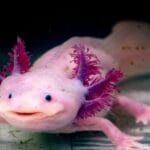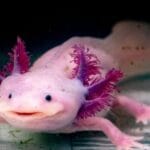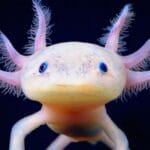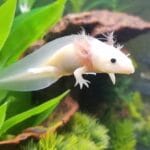Unveiling the Mysteries of the Axolotl’s “Forever Young” Life
The axolotl, a captivating creature from the lakes of Mexico, has taken the world by storm with its permanent “baby face” and regenerative superpowers. Unlike their froggy relatives who transition to land, axolotls usually prefer to keep their youthful charm—and their underwater lifestyle. This phenomenon, known as neoteny, is just one of the many intriguing aspects of the axolotl life cycle.
A Life Aquatic: Charting the Journey from Egg to Adult
The axolotl’s journey is full of fascinating twists and turns, and it all begins with a tiny, jelly-like egg.
-
Egg Stage: A Miniature Underwater Garden: A female axolotl doesn’t just lay a few eggs—she can lay hundreds, sometimes even exceeding 1,000! Picture a mesmerizing underwater garden with each egg carefully attached to plants. In about 10-14 days, these eggs hatch, revealing the tiniest axolotls imaginable.
-
Larval Stage: Gilled and Gorgeous: This stage is where the axolotl’s unique development truly shines. While most amphibians quickly outgrow their tadpole phase, axolotls take their time. For weeks, and even months, they sport adorable external gills (resembling feathery headbands!), a tadpole-like tail fin, and tiny, developing limbs. This is neoteny in action—remaining in this juvenile stage even as they grow larger.
-
Juvenile Stage: Teenage Transformations: At around six months old, axolotls enter their teenage years. Their limbs grow stronger, their unique adult colors begin to emerge, but those iconic gills remain. This is a period of significant growth, demanding a spacious environment and a varied diet to fuel their development.
-
Adult Stage: Adults with a Youthful Twist: By 18-24 months, axolotls are considered adults. They are sexually mature, capable of having their own offspring. They continue to possess those remarkable gills, a testament to their “forever young” status. With proper care in captivity, these amazing creatures can live for an impressive 10-15 years!
The Metamorphosis Mystery: Can Axolotls Grow Up?
You might be curious: do axolotls ever lose their gills and transition to land? While extremely rare in the wild, the answer is yes, they can! Under specific conditions, such as significant environmental changes or even a boost in iodine levels, an axolotl might undergo metamorphosis. This transformation involves trading their gills for lungs and adapting to a terrestrial life. However, this process is unusual and can be quite stressful for axolotls, so it’s not something that should be intentionally induced.
Protecting the “Peter Pan” of Salamanders
Learning about the axolotl life cycle isn’t just fascinating; it helps us understand how to best care for these exceptional creatures. Every stage, from egg to adult, has specific needs—tank size, water quality, diet, and even how we handle them—all playing a crucial role in their well-being.
Alarmingly, these “Peter Pans” of the animal world are critically endangered in the wild. Habitat loss, pollution, and invasive species pose significant threats to their survival. The good news is that captive breeding programs and dedicated efforts to restore their natural habitats offer a beacon of hope for axolotls. Their story serves as a powerful reminder that the natural world is full of wonders and that safeguarding even the most extraordinary creatures is vital.
How Long Does It Take for an Axolotl to Turn into a Salamander?
Axolotls, with their external gills and charming tail fin, usually live their lives fully embracing their aquatic existence. While they can remain in this youthful state their entire lives, certain factors might trigger a transformation into a land-dwelling salamander. But how long does this metamorphosis really take?
It’s not a quick flip of a switch. Instead, imagine a gradual transformation, akin to a caterpillar turning into a butterfly, but perhaps not as predictable. Some scientists suggest that initial changes might be observable within a month, while others believe it could take up to two years for the full transition to occur! That’s quite a range, highlighting the complexity of this process.
Several factors can influence the duration of metamorphosis. These include iodine levels in their surroundings, sudden environmental changes that induce stress, and even natural hormonal shifts. It’s a multifaceted process that scientists are still working to fully unravel.
While you might be tempted to try and initiate this transformation yourself, most experts strongly advise against it. Intentionally forcing an axolotl to morph is considered unethical and potentially harmful. It can disrupt their health and even shorten their lifespan.
Instead, let’s appreciate the wonders of neoteny. These remarkable creatures have evolved this way for a reason, and it’s part of what makes them so unique. If you’re fortunate enough to have an axolotl companion, provide them with a stable and loving environment, and allow them to determine their own path, whether they choose to remain a forever-young water dweller or embark on the journey to terrestrial living.
How Many Babies Do Axolotls Have?
Axolotls typically begin their families in the springtime, and when they do, prepare for an abundance of babies! A female axolotl possesses the remarkable ability to lay a staggering number of eggs at once – anywhere from 100 to an astounding 1,000! Imagine that bustling nursery! However, a clutch size between 200 and 300 eggs is more common.
Don’t envision giant chicken eggs; axolotl eggs are minuscule, measuring a mere 2 to 3 millimeters across. You could easily overlook them!
Why do axolotls have so many babies? Scientists believe it’s a survival strategy. In their native habitat in the lakes of Mexico City, axolotls face numerous predators eager to feast on them or their eggs. By producing a large number of offspring, the chances of at least some surviving to adulthood and continuing the axolotl lineage are significantly increased. It’s as if they’re hedging their bets in the game of life.
However, having a large brood comes with its own set of challenges. Factors like the mother’s age and health, her diet, and even the water quality can influence the number of eggs she lays. For instance, younger, healthier females tend to have larger clutches than their older counterparts. Just as a nutritious diet is essential for our well-being, a mother axolotl requires a diet rich in protein and essential nutrients to produce a large number of healthy eggs.
Laying hundreds of eggs demands a great deal of energy from a mother axolotl. It’s a physically demanding feat, akin to running a marathon! In some cases, females can become ill or even die after laying their eggs, particularly if they weren’t in optimal health beforehand. That’s why providing them with ample nutritious food, safe hiding spots, and minimizing stress during the egg-laying period is crucial. It’s an undeniably stressful time for these incredible creatures.
How Old Do Axolotls Live?
We’ve explored what makes axolotls so captivating, but what about their lifespan? It’s truly remarkable how long these creatures can live, especially considering the challenges they encounter in the wild.
Axolotls are renowned for their longevity, and rightfully so! In captivity, when provided with proper care, they can live for 15 years or more. Some even reach the ripe old age of 20! Their neoteny, that unique ability to retain their youthful, larval form throughout their lives, plays a part in their extended lifespan. Moreover, their slow metabolisms, a consequence of their cold-water origins, likely contribute to their remarkable longevity.
However, life in the wild is a different story. Wild axolotls face a multitude of threats, including pollution, shrinking habitats, and predation. These factors sadly limit their average lifespan to around 10 to 15 years.
So, how can we contribute to ensuring these amazing creatures live their longest, healthiest lives? For starters, if you’re considering welcoming an axolotl into your home, understand that it’s a significant responsibility to provide them with the right environment. Imagine creating a comfortable, safe haven for them—a spacious tank with clean water, a balanced diet of live or frozen foods, and a stress-free environment are all paramount to their well-being.
As for our wild axolotl friends, supporting conservation efforts is crucial. Protecting their remaining habitats is the most effective way to ensure their survival for generations to come.
The story of axolotl lifespans is a tale of two realities. While they possess the potential to live surprisingly long lives, particularly in captivity, it’s our responsibility to comprehend the threats they face and take action to protect these unique and fascinating creatures.
Want to learn more about fascinating aquatic creatures? You won’t believe how much an Asian Arowana dragon fish can cost or how long an axolotl can outlive a dog!
- Jerry McSorley’s Post-Divorce Life: New Beginnings - July 16, 2025
- The Rise and Fall of the New Haven Nighthawks: A Minor League Hockey Legacy - July 16, 2025
- Unlock Jerry McSorley’s Career Highlights: Eye Tax Inc.’s Solar Success - July 16, 2025

















2 thoughts on “The Axolotl Life Cycle: From Adorable Egg to Eternal Youth”
Comments are closed.